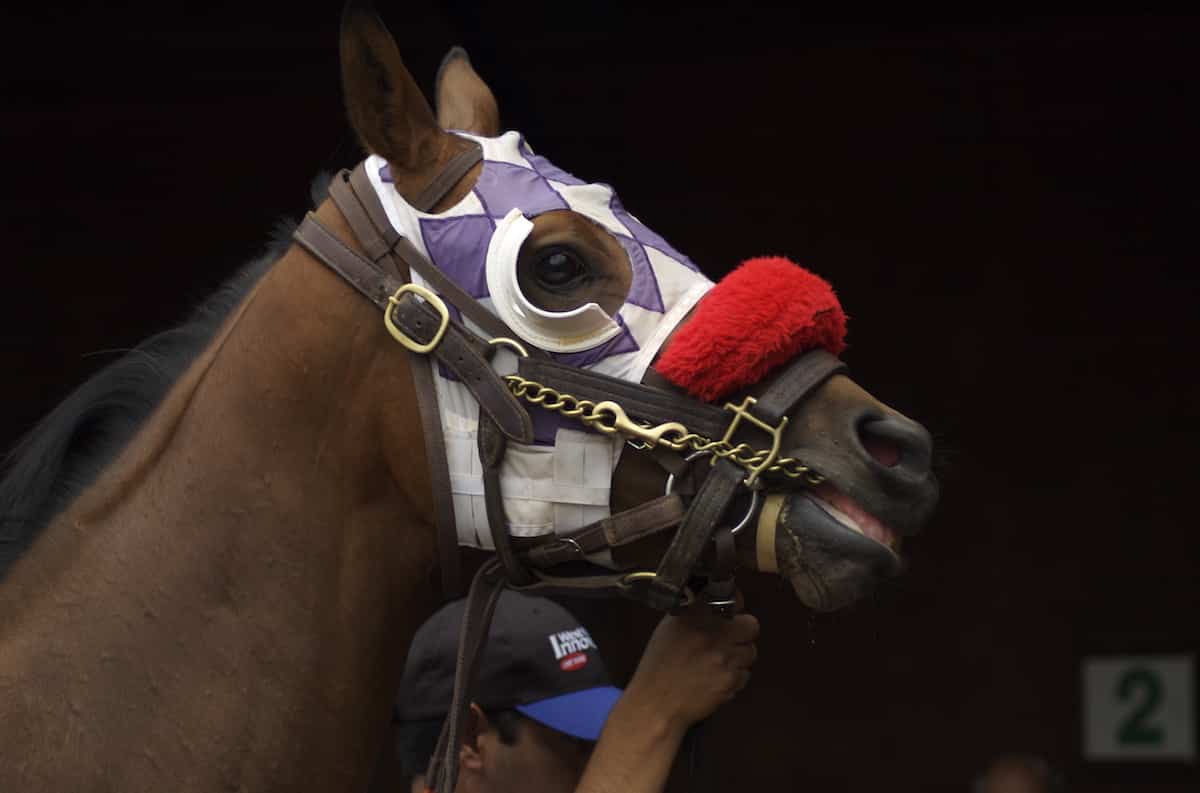Specialized tack and equipment help horses run their best race

Equipment you might spot on a racehorse’s head includes blinkers, a shadow roll and/or a tongue tie. Courtesy Flickr CC/Jeff Kubina
Head to a racetrack for morning workouts, and you’ll see horses wearing what look like typical English saddles. Return during the races, though, and the picture changes considerably. Gone are the galloping saddles, replaced by tiny scraps of leather that could hardly hold most of us in place.
Just as with any other discipline, racehorses wear gear that helps them do their job. The trick for trainers, though, is keeping that gear as light as possible. Conventional wisdom says every extra pound of jockey and tack a horse carries costs a length of distance, and sometimes margins as small as a nose, head or neck determine the difference between victory and defeat.
That’s why racing has developed the itty-bitty saddle. A race’s conditions determine how much weight each horse must carry. Jockeys provide their own saddle for a race, and many have multiple saddles that weigh anywhere from 2 to 10 pounds.
Lighter jockeys can use larger saddles, while heavier jockeys might switch saddles from race to race, depending on their weight assignment. If a jockey and the equipment don’t reach the assigned weight, weighted saddle pads are added to make up the difference.
Jockeys use correspondingly lighter stirrups made of such material as aluminum, carbon fiber or even titanium. The stirrup leathers are much shorter than those on a regular English saddle because a horse can usually run faster if the jockey rides compactly over the withers.
Saddle towels play a crucial role. They identify the horse’s program number for bettors and, in the case of stakes races, include the race name and, usually, the horse’s name.
The color of the saddle towel corresponds with the horse’s number. That way, bettors can more easily follow the horse they backed with their money. Typically, entry No. 1 is red, No. 2 is white, No. 3 is blue and on down the line.
The smaller saddles also don’t use a normal English saddle girth. Instead, racing girths are elastic, and trainers typically add an elastic overgirth, which goes over the horse’s back across the saddle. The primary advantage to racing girths is their lighter weight compared to the leather girths used with regular English saddles.
The undergirth buckles to billets on each side of the saddle, similar to an English saddle. The overgirth buckles underneath the horse’s rib cage — double protection to hold the saddle in place while the horse is sprinting at top speed.
Even so, occasionally a saddle can slip during a race. Triple Crown winner Affirmed famously lost the 1978 Jockey Club Gold Cup because jockey Steve Cauthen’s saddle slipped early in the race. Affirmed ran fifth, the only time he finished worse than third in his career.
You might also notice racehorses outfitted with blinkers. The nonracing world typically associates blinkers with driving horses, and those blinkers are square or rectangular pieces attached to the bridle to prevent the horse from shying at distractions.
Racehorse trainers hope to achieve the same thing, but racehorse blinkers look completely different. They are sewn into a hood that fits over the horse’s head and come in a variety of sizes.
“I’m going to guess that about 40 percent of our horses run in blinkers,” says Peter Eurton, a Southern-California-based trainer whose charges have included champion and Breeders’ Cup winner Champagne Room. He says young horses are especially easily distracted, so “sometimes they can start out in blinkers and grow out of it. It helps them focus.”
Champagne Room didn’t race in blinkers, but Eurton trainee Ashleyluvssugar, a millionaire 7-year-old gelding who is still racing, does.
“A lot of young 2-year-olds wear just a very small French cup,” says Eurton. “It’s cut down to maybe a half-inch. Sometimes we get horses that really look around, and we’ll put a full cup on them,” which covers about half the eye.
Bettors have noticed that when horses that have been running without blinkers begin wearing them, they sometimes have more early speed in a race, going right to the lead.
“The horses are actually paying attention (in blinkers),” Eurton says. “They get in more of a competitive mode versus looking around. The jockey may not have been able to get the horse’s attention during the race (without blinkers).”
Another potential distraction? Noise. Blinker hoods can also include earpieces to block loud sounds.
John Shirreffs, trainer of superstar mare Zenyatta, says “Thoroughbreds are sensitive to noise. They react to noise a lot, so this just muffles it a little bit.”
An even easier solution than earpieces is to put cotton in the horse’s ears, either for the entire race or just during the post-parade, when the horses walk past what might be a noisy crowd in the grandstand. Zenyatta wore cotton for this reason, says Shirreffs.
As with other disciplines, racehorse trainers decide what type of bit to use based on the horse’s job — in this case, racing — and the individual. Eurton says he primarily uses a D-ring snaffle because “it’s not very severe and is very light.”
If the rider needs a little more control, Eurton says he might switch to a loose ring snaffle.
Two other items a racehorse sometimes wears on his head are a shadow roll and a tongue tie.
The shadow roll fits over the noseband of the bridle. Usually made of sheepskin, it varies in size, depending on what the trainer feels the horse needs. It gets its name because its primary purpose is to keep a horse from jumping shadows. Depending on the time of day and how a racetrack grandstand sits relative to the sun, the building can cast shadows onto the track surface, often near the finish line.
Perhaps the most famous example of how a shadow roll might have helped a horse occurred in the 1990 Breeders’ Cup Sprint. Dayjur and Safely Kept battled heads apart toward the finish. As they approached the line, Dayjur jumped the grandstand’s shadow. It slowed him down just enough that he lost the race.
A tongue tie enhances a horse’s ability to breathe. Trainers will take a long strip of material — sometimes simply a ribbon of cotton sheet — and tie a horse’s tongue to his lower jaw.
“We probably use a tongue tie on 90-95 percent of our horses,” says Eurton. “We don’t want them getting their tongue over the bit. It also helps them if they possibly displace their soft palate,” referring to a common upper airway obstruction that causes poor performance and abnormal noise while exercising.
Racehorse trainers use a variety of bandages and boots to protect a horse’s legs. Sometimes a horse comes to the saddling paddock in protective bandages and bell boots, which the groom removes before the trainer saddles the horse. Other times, a horse races in bandages but, for safety reasons, never in bell boots.
“We’ll use bandages occasionally if a horse runs down (burns his fetlocks or pasterns on the track surface) or hits himself,” also known as interference, says Eurton. “Sometimes we use them for support.”
Knowing what gear will help each horse is part of the art of training racehorses. It is one of many tools a trainer uses to help horses reach their full potential on the track.
This article was originally published in the Fall 2018 issue of Off-Track Thoroughbred Magazine, the only publication dedicated to the Thoroughbred ex-racehorse in second careers. Want four information-packed issues a year delivered to your door or your favorite digital device? Subscribe now!

